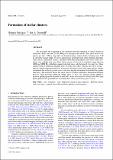Formation of stellar clusters
Abstract
We investigate the triggering of star formation and the formation of stellar clusters in molecular clouds which form as the interstellar medium passes through spiral shocks. The spiral shock compresses gas into an ∼100 pc long main star formation ridge, where clusters form every 5–10 pc along the merger ridge. We use a gravitational potential-based cluster finding algorithm, which extracts individual clusters, calculates their physical properties and traces cluster evolution over multiple time-steps. Final cluster masses at the end of simulation range between 1000 and 30 000 M⊙ with their characteristic half-mass radii between 0.1 and 2 pc. These clusters form by gathering material from 10–20 pc size scales. Clusters also show a mass-specific angular momentum relation, where more massive clusters have larger specific angular momentum due to the larger size scales, and hence angular momentum from which they gather their mass. The evolution shows that more massive clusters experience hierarchical merging process, which increases stellar age spreads up to 2–3 Myr. Less massive clusters appear to grow by gathering nearby recently formed sinks, while more massive clusters with their large global gravitational potentials are increasing their mass growth from gas accretion.
Citation
Smilgys , R & Bonnell , I A 2017 , ' Formation of stellar clusters ' , Monthly Notices of the Royal Astronomical Society , vol. 472 , no. 4 , pp. 4982-4991 . https://doi.org/10.1093/mnras/stx2396
Publication
Monthly Notices of the Royal Astronomical Society
Status
Peer reviewed
ISSN
0035-8711Type
Journal article
Collections
Items in the St Andrews Research Repository are protected by copyright, with all rights reserved, unless otherwise indicated.

